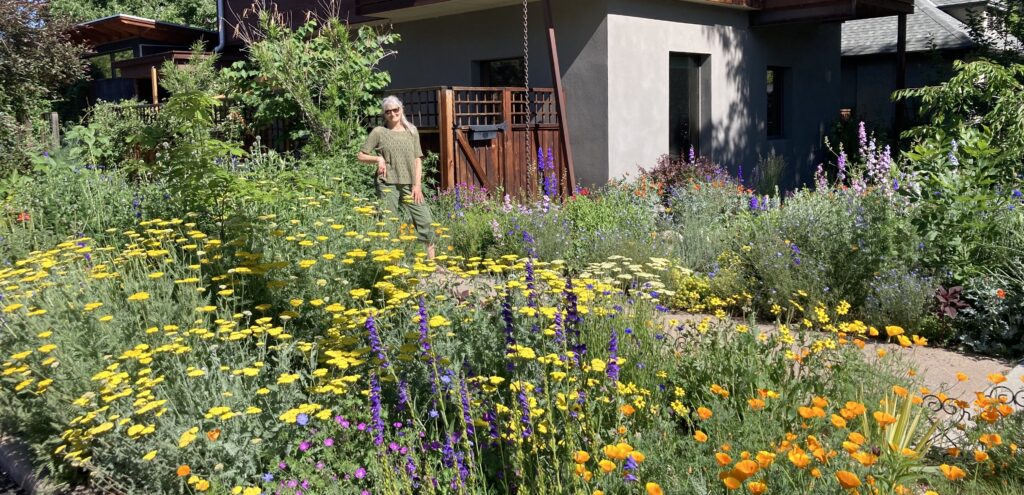By Deb Lebow Aal
Jonathan Sciarcon in his article “Consider Rewilding Your Yard with Aggressive Native Plants” has made a great case for strategically placing what he calls aggressive native plants, and what I call garden thugs, in your yard. I heartily agree with his arguments and have a few more to add to the list.
First a definition of a garden thug. It is a plant that is annoyingly overenthusiastic. It starts out in the place you wanted it and ends up – everywhere! Now, if you are starting with a blank slate and want to fill up your yard fast, these are just the plants for you! But, if you like at least a little bit of order, or if you have a rather small yard, you will want to know more about these plants before including them, or know that you will be editing out quite a bit. I am not saying avoid these – they are great Colorado native plants, just know what you’re dealing with.
We are not talking about noxious weeds, or invasive plants on the noxious weeds list. That’s a whole different category of plants that are not native and should be avoided at all costs. Here is the Colorado invasive plants list.
With all of the plants listed below, despite the fact that they are thugs, I keep most of them in my yard because they provide such stellar ecosystem services. You can control these thugs by cutting off the flowers before they’ve gone to seed, if that is the way they spread. If they spread via rhizomes, it’s a bit more work. And, since I actually like weeding, I am out there doing lots of editing,

Here are my additions to Jonathan’s list of garden thugs, from my experience.
Baby Blue Rabbit Brush (Ericameria nauseosa): Such a beautiful plant with its blue green foliage all year round, and yellow flowers so late in the season, but if you have one, you have many. I have been able to pull them out easily, where I don’t want them, but you have to be on top of them. An important plant for erosion control, with its very deep roots, and very xeric.
Stiff-leaved Goldenrod (Solidago rigida): Also yellow flowers, and also a late-season bloomer. It is everywhere in my yard. If you have what you consider “bad” soil, it doesn’t care, so put it there.

Chocolate Flower (Berlandiera lyrata): When I started converting my garden to more natives, I put in chocolate flower, and it did not thrive. This did not make sense, as everyone I knew said it would grow anywhere. Well, once it took hold, it took hold! It likes the driest, most neglected corners of my garden, which is great! But it does get rangy and unkempt looking if not cut back mid-season. The blooms are fabulous, it does smell like chocolate, and I would never be without this plant.
Rocky Mountain Penstemon (Penstemon strictus): At higher elevations, this penstemon has been known to take over, but who cares? It’s gorgeous! I have let it go, and it has overwhelmed tamer species, like Gaillardia and Linum lewisii, but that’s okay with me. The blue/purple flower is divine, and as goes for all these plants, great ecosystem species.
Western Spiderwort (Tradescantia occidentalis): I planted this in my rain garden, as it likes moister soils, and it has quickly spread. Again, it’s very easy to thin, and the blue flowers are gorgeous, so I have let it do its thing.
Yarrow (Achillea millefolium): The native with the white flowers will reseed readily, if given enough water. Actually, that can be said of all of these. If not given much water, they will be much tamer (except for rabbit brush and chocolate flower!).
Blue larkspur (Delphinium nuttallianum): This one I am not sure of. I was given seeds of what I thought were the native larkspur, and they took over quickly. They are beautiful – purple, pink and white long-lived blooms, mid-season, but they spread to every corner of my yard. So, I suspect I may have been given the European version of this plant. I am not sure our native larkspur would behave this way, but I would love to know others’ experience with this plant. This is the only plant on the list that I have completely eradicated from my yard (or attempted to – it still pops up) as it was way too aggressive.
Common sunflower (Helianthus annuus): Late season yellow, again. The finches love these plants, so they are worthy of your yard, but yes, they reseed heavily. Again, easy to edit out early in the season.
Buffalo Grass (Bouteloua dactyloides) and Blue Grama Grass (Bouteloua gracilis): As Jonathan noted, and it bears repeating, these are great grasses to add to the list of competitive plants, particularly for those who want to keep a more manicured look. It’s a great option for hot, dry areas where you’d like a low maintenance lawn, and these two grasses can be planted together, to combine the best attributes of both. A research study in the January 1950 volume of Ecology showed that buffalo grass, regularly mowed (i.e., every two weeks, perhaps) to a height of 1 inch eliminated established bindweed from a site in 3-5 years1. Wow – that’s a win!
And a few others I have heard are also aggressive, again, when water is plentiful are: Panicum virgatum (switchgrass), Helianthus pauciflorus (stiff sunflower), Rhus trilobata (three-leaf sumac) and Quercus gambelii (Gambel oak).
We would love to hear your experience! Please email me with your experience of garden thugs in your yard!
- Reference: The article in the January 1950 volume of Ecology was titled “Competitive Relationships of Four Different Lawn Grasses with Field Bindweed and Dandelion Under Frequent Close Clipping”, written by F.L. Timmons. ↩︎
